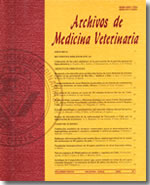Diagnostic evaluation of chromatographic fractions of Fasciola hepatica by Western Blot and ELISA in infected animals
Main Article Content
Abstract
The antigenic components of excretory-secretory products of adult F. hepatica, were separated by gel filtration chromatography (Sephacryl S-300) and then analized by polyacrylamide gel electrophoresis (SDS-PAGE), followed by Western Blot (WB). In order to evaluate the sensitivity, specificity and predictive value of the selected fractions an enzyme-linked immunosorbent assay (ELISA) was used with sera from sheep, swine and horses infected with F. hepatica, as well as with control sera (uninfected animals).
The chromatographic curve presented up to 5 peaks, representing polypeptides with a molecular weight of 2000, 400, 150, 29 and less than 29 kDa, according to the interpolation with a standard curve of commercial polypeptide molecular weights. The results obtained with SDS-PAGE and WB using sera from the three species, indicated that those fractions of 400, 150, 29 and <29 kDa contained polypeptides, specifically recognized only by infected animals. When these fractions were evaluated with sheep, horse and swine sera by means of ELISA, the most efficient fraction was the 29 kDa, exhibiting an average sensitivity and specificity of 94.5% and 93.5%, respectively in the three species. The SDS-PAGE and WB assay of this fraction showed the presence of two immunoreactive bands, a 29 kDa and another of 14 kDa.
According to these results, it is concluded that the polypeptides contained in the 29 kDa chromatographic fraction would be suitable specific antigens, since they discriminate between infected and non infected F. hepatica animals. This fraction was also efficient in diagnosing fasciolosis in the prepatent stage of the infection in sheep. Therefore this fraction should be further studied and purified as it constitutes a prominent immunodiagnostic fraction which may be used for mass screening studies of fasciolosis using an ELISA test.

